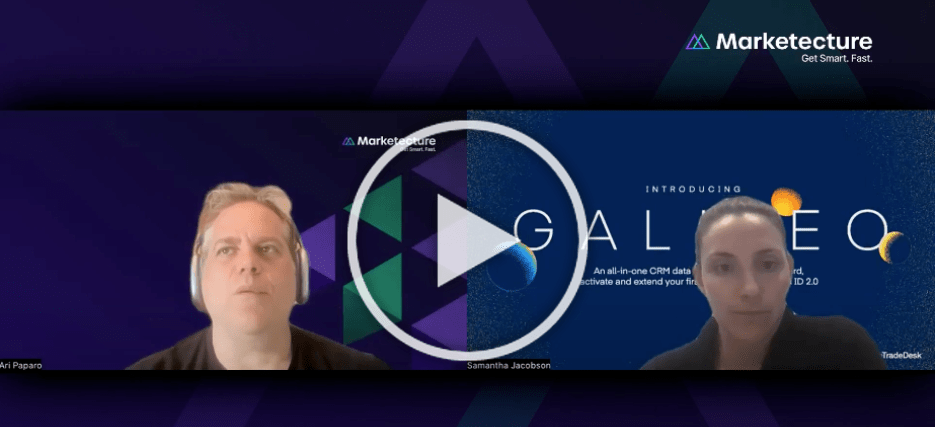Save 50% on a 3-month Digiday+ membership. Ends Dec 5.
How The Trade Desk is evolving its approach to first-party data and IDs

Produced in partnership with Marketecture
The following article highlights an interview between Samantha Jacobson, Chief Strategy Officer of The Trade Desk, and Ari Paparo, founder and CEO of Marketecture. Register for free to watch more of the discussion and learn how The Trade Desk is changing its approach to first-party data management and more.
With next year’s third-party cookie deprecation deadline looming, digital advertisers continue experimenting with new tools to help them navigate the changing landscape.
Advertisers are increasingly leveraging first-party data, but buyers face obstacles with audience matching across a fragmented ecosystem of identity tools and solutions. Samantha Jacobson, Chief Strategy Officer of The Trade Desk, recently spoke with Ari Paparo, founder and CEO of Marketecture, to discuss how the demand-side platform is helping advertisers manage data and improve identity signals.
“Clients are trying to make sure they’re leveraging their first-party data as effectively as possible, and it’s a surprisingly new space for a lot of them,” Jacobson said. “Historically, some of those departments have been separate within those organizations, or they’ve uploaded it and have not known how to maximize that data.”
Native email uploads are boosting advertiser campaigns
For years, advertisers have relied on third-party cookies as powerful tools for a fragmented and disjointed ad tech ecosystem. As first-party data comes into focus, The Trade Desk recognized an opportunity to streamline advertisers’ process for matching different audience types using other technologies.
In January, The Trade Desk launched Galileo, an offering that allows advertisers to upload their first-party data, including email addresses, to target relevant audiences on the open web. Allowing native email uploads has been a boon for advertisers; email addresses continue growing in value, indicative of a direct relationship between a brand and a consumer.
For matching purposes, Galileo supports several audience IDs, including The Trade Desk’s Unified ID 2.0 (UID2), and has integrations with CRM, CDP and cleanroom providers such as Adobe, Habu, Experian, Salesforce and Snowflake.
“UID2 is not a reaction to cookies going away, but instead a recognition that technology has evolved, and we need a consistent way for us to understand users in those ecosystems,” Jacobson said.
According to Jacobson, Trade Desk partners are creating clean rooms as a privacy-first solution to pull in different data attributes and using that to mine their CRM files to create seed audiences, such as the most lucrative buyers.
“Partners also recognize that they have blind spots in terms of how buyers are behaving at their competitors or in different ecosystems,” Jacobson said. “We find that they’re then augmenting that with different third-party assets we have available to get the best of both worlds and then choosing to buy against those IDs.”
How streaming platforms are unlocking first-party data matching
Challenges with fragmentation and user IDs also extend to another prized channel among digital advertisers: connected TV.
“The CTV space is perfectly fragmented,” Jacobson said. “Buyers want to buy across different ecosystems, but they want to make sure they can understand reach and frequency to control the number of times they are exposing a user to an ad across different places. UID2 allows them to do that very effectively.”
Trade Desk partners like Disney, NBCUniversal and Paramount already use UID2 to help advertisers match their first-party data against streaming inventory.
While streaming television may not fit the traditional definition of anonymous viewership, as Paparo and Jacobson discussed, CTV is often considered to be household-based rather than consumer-based. However, because accounts for streaming platforms are associated with individuals, it enables UID2.
“Just as advertisers work with partners to understand how they think about householding or who users are, they can work with those same providers to think through the grouping of how they would cluster UID2 or different emails in a given household,” Jacobson said. “That’s where we expect partners to be able to apply their view of that logic. We don’t want to be dictating what we see as the truth in that regard.”
Register for free to watch more of the discussion between Ari Paparo and Samantha Jacobson and learn how changes in data management and online identity impact advertisers.
More from Digiday

In Graphic Detail: CMOs at a crossroads of power and proof
CMOs are closing out another year defined by churn and shifting ground.

AI-powered professional learning and the battle vs. ‘workslop’: Inside Deloitte’s Scout
Deloitte last month launched Scout as part of its Project 120, the company’s $1.4 billion investment in professional development.

As Black Friday nears, fake apologies from brands are all over Instagram
Brands have taken to social media in advance of Bliack Friday to ask followers for forgiveness. The catch: They’re apologizing for their products being too good.





